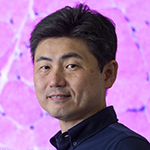Message from President
|
Ichizo Nishino, MD, PhD
President, Asian and Oceanian Myology Center (AOMC) |
 |
Welcome to the Asian and Oceanian Myology Center (AOMC)
It is with much delight that I greet you on behalf of the AOMC, an organization with a remarkable journey that spans for more than two decades as we work for the advancement of neuromuscular medicine and science.
Since our inaugural meeting in Tokyo in 2001, the AOMC has grown into a vibrant and mutually supportive society that is dedicated to enhancing the understanding of and care for patients with neuromuscular disorders across the Asian and Oceanian region.
Our history is a testament to the power of collaboration and shared vision. What began as a modest gathering in Tokyo has evolved into a dynamic series of meetings that have enriched our knowledge, strengthened our bonds, and propelled the field of neuromuscular research forward. From that first moment in 2001, when like-minded professionals from diverse backgrounds convened to exchange ideas, we have nurtured a spirit of camaraderie and mutual support that remains steadfast at the heart of the AOMC.
Throughout our journey, the AOMC has consistently embraced our mission to promote basic and clinical scientific research, elevate patient care, and provide a platform for interdisciplinary collaboration. Our annual meetings have become hallmark events, fostering the exchange of cutting-edge insights and nurturing the growth of young investigators and clinicians.
As we look to the future, we are excited to announce that the 19th AOMC meeting is scheduled to take place in October 2023 in the vibrant Shanghai, China, followed by the 20th meeting in September 2024 in the picturesque Nara, Japan. These gatherings are not merely conferences, but are milestones that celebrate the progress that we have collectively achieved and the potential that lies ahead.
AOMC has always been more than an organization and stands for being a community of dedicated professionals who are passionate about advancing neuromuscular medicine. Our journey of more than 20 years is a testament to the commitment, expertise, and collaborative spirit that our members bring to the field.
Thank you for your interest in the AOMC. Whether you are a seasoned expert, a young investigator, a clinician, or simply someone curious about neuromuscular health, we invite you to explore our resources, engage with our community, and join us in shaping the future of neuromuscular medicine and science.
Warmest regards,
August 2023
It is with much delight that I greet you on behalf of the AOMC, an organization with a remarkable journey that spans for more than two decades as we work for the advancement of neuromuscular medicine and science.
Since our inaugural meeting in Tokyo in 2001, the AOMC has grown into a vibrant and mutually supportive society that is dedicated to enhancing the understanding of and care for patients with neuromuscular disorders across the Asian and Oceanian region.
Our history is a testament to the power of collaboration and shared vision. What began as a modest gathering in Tokyo has evolved into a dynamic series of meetings that have enriched our knowledge, strengthened our bonds, and propelled the field of neuromuscular research forward. From that first moment in 2001, when like-minded professionals from diverse backgrounds convened to exchange ideas, we have nurtured a spirit of camaraderie and mutual support that remains steadfast at the heart of the AOMC.
Throughout our journey, the AOMC has consistently embraced our mission to promote basic and clinical scientific research, elevate patient care, and provide a platform for interdisciplinary collaboration. Our annual meetings have become hallmark events, fostering the exchange of cutting-edge insights and nurturing the growth of young investigators and clinicians.
As we look to the future, we are excited to announce that the 19th AOMC meeting is scheduled to take place in October 2023 in the vibrant Shanghai, China, followed by the 20th meeting in September 2024 in the picturesque Nara, Japan. These gatherings are not merely conferences, but are milestones that celebrate the progress that we have collectively achieved and the potential that lies ahead.
AOMC has always been more than an organization and stands for being a community of dedicated professionals who are passionate about advancing neuromuscular medicine. Our journey of more than 20 years is a testament to the commitment, expertise, and collaborative spirit that our members bring to the field.
Thank you for your interest in the AOMC. Whether you are a seasoned expert, a young investigator, a clinician, or simply someone curious about neuromuscular health, we invite you to explore our resources, engage with our community, and join us in shaping the future of neuromuscular medicine and science.
Warmest regards,
August 2023
